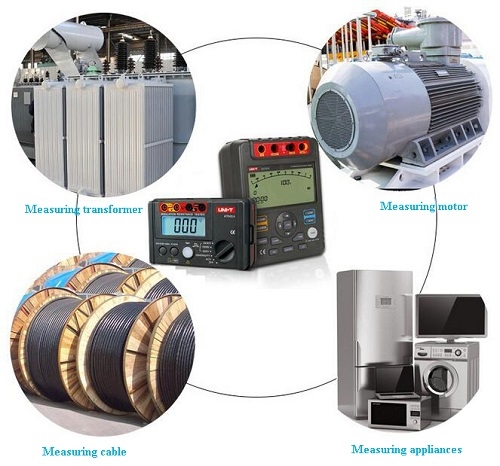An Insulation Resistance Tester, often referred to as a "megohmmeter" or simply "megger," is an electrical testing instrument used to measure the electrical resistance of insulating materials. Its primary purpose is to evaluate the integrity and quality of insulation in electrical systems, cables, wires, windings, and other components. This type of testing helps ensure the safe and reliable operation of electrical equipment and systems.
Operating Principle
Insulation resistance testers are based on Ohm's law. The value of insulation resistance can be calculated by loading a known DC voltage and measuring the current flowing through the insulating material. Theoretically, the value of insulation resistance is large, but not infinite, so by measuring the insulation material with a small current, the insulation resistance tester calculates and displays the value of the insulation resistance, which represents how good the insulation material is. The electrical insulation between two conductors indicates the risk of leakage currents in the insulating material.
Applications and Uses
- Electrical Equipment Maintenance and Testing: One of the most common uses of insulation resistance testers is in the maintenance and testing of electrical equipment. It helps identify insulation issues, such as deterioration, contamination, or damage, in cables, wires, transformers, motors, generators, and other electrical components.
- Predictive Maintenance: Insulation resistance testing is an essential part of predictive maintenance programs. By periodically measuring the insulation resistance of electrical systems and comparing the results to baseline values, maintenance personnel can detect potential issues early and schedule repairs before they lead to costly breakdowns or failures.
- Quality Control in Manufacturing: Manufacturers of electrical equipment use insulation resistance testing as part of quality control processes to ensure that products meet industry standards and specifications. It helps verify the integrity of insulation in newly manufactured equipment.
- Commissioning New Electrical Systems: When new electrical systems are installed or commissioned, insulation resistance testing is performed to confirm that the insulation is intact and that there are no immediate issues with the newly installed components.
- Troubleshooting Electrical Problems: When electrical systems experience malfunctions, insulation resistance testing can be used as a diagnostic tool to pinpoint the source of the problem. For example, it can help identify whether an electrical fault is due to insulation breakdown.
- Safety Verification: Ensuring the integrity of insulation is crucial for electrical safety. Insulation resistance testing is a safety measure to prevent electrical accidents and fires, especially in older systems that may have deteriorating insulation.
- Compliance with Regulations: Some industries and electrical installations are subject to regulations and standards that require periodic insulation resistance testing. Compliance with these standards is essential for safety and legal reasons.
- Testing High Voltage Insulation: Insulation resistance testers are often used in high-voltage applications to assess the insulation of power lines, substations, and high-voltage equipment. High-voltage insulation testing typically involves higher voltage and current levels.
- Measuring Moisture Content: Insulation resistance testing can also provide information about the moisture content of insulation materials.Moisture can significantly affect the insulating properties of materials.

Key Features and Functions
- Resistance Measurement: The primary function of an insulation resistance tester is to measure the electrical resistance of insulating materials. It provides a quantitative measure of the insulation's ability to resist the flow of electrical current.
- High-Voltage DC Output: Insulation resistance testers generate a high-voltage direct current (DC) signal, typically in the range of 250 volts to several kilovolts. This voltage is applied to the insulation being tested to stress it and detect any potential issues or weaknesses.
- Current Measurement: The instrument measures the current that flows through the insulation when the high-voltage DC signal is applied. This current, often referred to as leakage current, is a key parameter for assessing the condition of the insulation.
- Resistance Calculation: Using Ohm's law (V=I*R), the tester calculates the insulation resistance (R) by dividing the applied voltage (V) by the measured current (I). The resulting value is expressed in ohms.
- Display and Recording: The insulation resistance tester typically displays the measured insulation resistance value on its screen. Some models also provide graphical displays and data-logging capabilities, allowing users to record and analyze the results over time.
- Safety Features: Insulation resistance testers often include safety features such as voltage interlock systems and discharge mechanisms to protect the operator and the equipment under test.
Importance
- Electrical Equipment Maintenance: Regular testing is essential to ensure the integrity of insulation in electrical systems, motors, transformers, generators, and other equipment.
- Predictive Maintenance: By periodically measuring insulation resistance and comparing it to baseline values, maintenance personnel can detect potential issues early and schedule repairs before they lead to costly breakdowns or failures.
- Quality Control: Manufacturers use these instruments to verify the quality of insulation in newly manufactured electrical components and equipment.
- Safety Verification: Insulation resistance testing is a safety measure to prevent electrical accidents and fires, especially in older systems that may have deteriorating insulation.
- Compliance with Regulations: Some industries and electrical installations are subject to regulations and standards that require periodic insulation resistance testing.
- Troubleshooting: When electrical systems experience issues, insulation resistance testing can help pinpoint the source of the problem.
Insulation resistance testers come in various models with different voltage ranges, measurement capabilities, and additional features. The choice of a specific model depends on the application and the voltage levels involved. The sisco store can provide you with a choice of insulation resistance testers.

